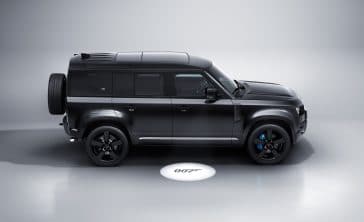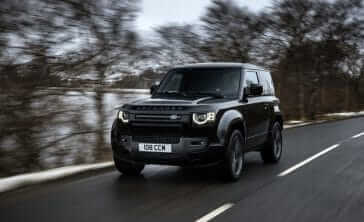Model review
The Land Rover Discovery Sport is an SUV that aims at giving buyers a smaller and more affordable alternative to the full-fat Discovery. Launched in 2015, the model acts as the successor to the Freelander 2, picking up where the popular car left off.
The original Sport is based on the same platform (derived from an aging Ford one) as the first-generation Range Rover Evoque. However, it must be said that 90 per cent of its components were redesigned to meet the manufacturer’s specific demands, mainly to cope with off-roading.
The model’s engine range was initially comprised of Ford units carried over from the outgoing Freelander 2. But for the 2016 model year, they were replaced by a line of Jaguar Land Rover’s newer Ingenium motors.
Although still in its first generation, which is no bad thing, the SUV has been brought bang up to date due to receiving a facelift for 2019.
Current model
As mentioned before, the Sport got a fairly significant facelift for 2019. One that has really helped the model stay competitive with newer rivals. Buyers with the budget for a refreshed Discovery Sport should definitely consider going for the upgrade over the pre-facelift version.
For starters, it hasn’t just been given a new lick of paint and sent back out onto the market. In reality, changes can be found underneath the Sport’s updated styling. One notable alteration is its platform, which is all new. Considering the old basis for the sport was noticeably aging, this is good news.
Another great thing that shows this refreshed version means business is the introduction of mild-hybrid technology. It’s available on all engines except the base diesel, meaning there’s plenty of scope for buyers to enjoy fuel-saving benefits.
Out on the road, and off it for that matter, the Discovery Sport is among the best in its class. Apart from the suspension proving a bit harsh in places, we have little to complain about. For an SUV, the steering and overall dynamics are rather impressive. Sure, it’s maybe not as sporty as the name ‘Sport’ suggests, but it’s really rather good.
Value for money
New Discovery Sport models are priced from £31,575, which is actually quite a bit cheaper than German rivals such as the Audi Q5 (£41,420) and BMW X3 (£40,335). Spring for the higher trim level and ticking a few optional extras can get expensive, but stick around entry-level variants and buyers will find themselves getting very good value for money.
In terms of used Sports, there are some good deals out there as well. Cheapest ones go for around £14,000. Unfortunately, the modernised facelift version is too new to find any amazing bargains just yet, however, pre-facelift cars are still a fantastic buy, especially at that price point.
Looks and image
The Disco Sport, as it’s sometimes referred to, isn’t perhaps the most stylish car in its class. Its design is arguably a bit too familiar to be setting any trends. That being said, the SUV is certainly handsome and a far cry from ugly, particularly in facelifted form.
The updated exterior of the refreshed iteration raises the bar in terms of sportiness, premium, modern looks and road presence. It may not be able to match the Range Rover Velar or the larger Discovery, but the Sport definitely comes close in those areas.
Space and practicality
Despite the SUV being relatively compact, it makes good use of the space. The cabin is nice and roomy, allowing passengers to easily get comfortable. The model is also available with seven seats, although the third row is better suited to children rather than tall adults (shorter adults might be able to squeeze in for shorter journeys).
With regards to boot space, it naturally isn’t as generous as larger SUVs or even estate cars. But at 754 litres with the third row folded down, it’ll be more than adequate for most people. And if that’s not enough, the second row can always be folded down too, revealing 1,794 litres of space.
Engines
The Sport’s engine range is currently comprised of diesel and petrol offerings. On the latter front, there’s a 2.0-litre four-cylinder available with two power outputs; 197bhp, badged P200, and 247bhp, dubbed the P250. Both are good performers, but the lower-powered version needs a little bit more work to get the best out of it.
On the diesel side of things, another 2.0-litre motor is available, this time offered in three power outputs of 148bhp, 178bhp and 237bhp. The highest power diesel is the one to go for as its potent yet cheap to run. It’s worth noting that it is quite expensive to opt for, though.
Running costs
For the cheapest running costs, buyers will want to get the 148bhp diesel unit coupled with a manual gearbox and front-wheel-drive. In this configuration, the Sport is said to be able to achieve up to 47.8mpg and emit 140g/km of CO2.
All other versions of the SUV come with four-wheel-drive and seven seats, with economy dipping into the high 30s when it comes to the diesels, and low 30s for the petrol units. For the segment, those numbers add up to rather cheap running costs. Plus, all engines except the entry-level diesel get mild-hybrid tech to help out.
Things to look out for
One of the reasons Land Rover decided to ditch the Freelander nameplate for its successor was that the company felt it had gained a reputation of being unreliable. With this in mind, the Discovery Sport had to serve owners well, to avoid the same fate. And overall, it seems the model has proven a reliable choice, with strong build quality and a five-star crash test rating.
On the other hand, reliability issues were raised about the Land Rover brand as a whole during driver satisfaction surveys, with quite a few owners finding faults with their cars within the first year of ownership.
Rivals
The SUV segment is very popular nowadays, resulting in more manufacturers producing them in all different sizes. With the Discovery Sport sitting around the middle in this department, it’s not without its competition. Rivals include the BMW X3 and Audi Q5, as well as more affordable, but very practical alternatives like the Hyundai Santa Fe and Skoda Kodiaq.
Depreciation
The Discovery Sport should hold its value pretty well thanks to its desirable bodystyle, good practicality with the option of seven seats and relatively affordable starting price. Residual values may be better if it wore the more prestigious Range Rover badge, but then again, it would be more expensive to buy in the first place. To put briefly, the Sport is a good buy that shouldn’t massively disappoint when it comes to selling it on.





